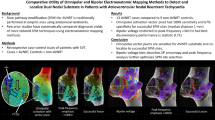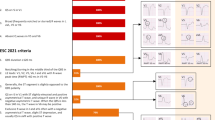Abstract
Background
The radiofrequency (RF) ablation target may be located at the compact atrioventricular node (AVN) region during so-called slow pathway (SP) RF ablation, potentially leading to transient or permanent atrioventricular block (AVB). However, related data are rare.
Methods
Among 715 index consecutive patients who underwent RF ablation for atrioventricular nodal re-entry tachycardia, 17 patients subsequently experienced transient or permanent AVB and were included in this retrospective observational study.
Results
Among the 17 patients, two patients (11.8%) developed transient first-degree AVB, four patients (23.5%) developed transient second-degree AVB, seven patients (41.2%) developed transient third-degree AVB, and four patients (23.5%) developed permanent third-degree AVB. During baseline sinus rhythm before the start of RF ablation, no His-bundle potential was recorded from the RF ablation catheter. During the so-called SP RF ablation that led to transient or permanent AVB, junctional rhythm with ventriculoatrial (VA) conduction block followed by subsequent AVB was observed in 14 of 17 patients (82.4%), and a low-amplitude, low-frequency hump-shaped atrial potential was recorded before the start of RF ablation in 7 of the 17 patients (41.2%). Direct AVB occurred in 3 of the 17 patients (17.6%), and a low-amplitude, low-frequency hump-shaped atrial potential was recorded before the start of RF ablation in all 3 patients.
Conclusions
The low-amplitude, low-frequency hump-shaped atrial potential recorded at the so-called SP region may reflect the electrogram of compact AVN activation, and RF ablation to this site heralds impending AVB even when a His-bundle potential is not recorded.




Similar content being viewed by others
Data availability
The datasets used and analyzed during the current study are available from the corresponding author on reasonable request.
References
Lee MA, Morady F, Kadish A, Schamp DJ, Chin MC, Scheinman MM, et al. Catheter modification of the atrioventricular junction with radiofrequency energy for control of atrioventricular nodal reentry tachycardia. Circulation. 1991;83:827–35.
Jackman WM, Beckman KJ, McClelland JH, Wang X, Friday KJ, Roman CA, et al. Treatment of supraventricular tachycardia due to atrioventricular nodal reentry by radiofrequency catheter ablation of slow-pathway conduction. N Engl J Med. 1992;327:313–8.
Mitrani RD, Klein LS, Hackett FK, Zipes DP, Miles WM. Radiofrequency ablation for atrioventricular node reentrant tachycardia: comparison between fast (anterior) and slow (posterior) pathway ablation. J Am Coll Cardiol. 1993;21:432–41.
Jazayeri MR, Hempe SL, Sra JS, Dhala AA, Blanck Z, Deshpande SS, et al. Selective transcatheter ablation of the fast and slow pathways using radiofrequency energy in patients with atrioventricular nodal reentrant tachycardia. Circulation. 1992;85:1318–28.
Li HG, Klein GJ, Stites HW, Zardini M, Morillo CA, Thakur RK, et al. Elimination of slow pathway conduction: an accurate indicator of clinical success after radiofrequency atrioventricular node modification. J Am Coll Cardiol. 1993;22:1849–53.
Page RL, Joglar JA, Caldwell MA, Calkins H, Conti JB, Deal BJ, et al. 2015 ACC/AHA/HRS guideline for the management of adult patients with supraventricular tachycardia: a report of the American College of Cardiology/American Heart Association Task Force on clinical practice guidelines and the Heart Rhythm Society. J Am Coll Cardiol. 2016;67:e27–e115.
Fragakis N, Krexi L, Kyriakou P, Sotiriadou M, Lazaridis C, Karamanolis A, et al. Electrophysiological markers predicting impeding AV-block during ablation of atrioventricular nodal reentry tachycardia. Pacing Clin Electrophysiol. 2018;41:7–13.
His W Jr. Die Tätigkeit des embryonalen herzens und deren bedeutung für die Lehre von der Hezebewegung beim menschen. Arbeiten aus der medidizinischen Klinik zu Leipzig. 1893:14–49.
Tawara S. Das Reizleitungssystem Des Saugetierherzens: Eine Anatomisch-Histologische Studie Uber Das Atrioventrikularbundel Und Die Purkinjeschen Faden. Jena, Germany: Fisher. 1906;9–70:114–56.
Katritsis DG, Becker A. The atrioventricular nodal reentrant tachycardia circuit: a proposal. Heart Rhythm. 2007;4:1354–60.
Markowitz SM, Lerman BB. A contemporary view of atrioventricular nodal physiology. J Interv Card Electrophysiol. 2018;52:271–9.
Padala SK, Cabrera JA, Ellenbogen KA. Anatomy of the cardiac conduction system. Pacing Clin Electrophysiol. 2021;44:15–25.
Cabrera JÁ, Anderson RH, Macías Y, Nevado-Medina J, Porta-Sánchez A, Rubio JM, et al. Variable arrangement of the atrioventricular conduction axis within the triangle of Koch: implications for permanent His bundle pacing. JACC Clin Electrophysiol. 2020;6:362–77.
Ueng KC, Chen SA, Chiang CE, Tai CT, Lee SH, Chiou CW, et al. Dimension and related anatomical distance of Koch’s triangle in patients with atrioventricular nodal reentrant tachycardia. J Cardiovasc Electrophysiol. 1996;7:1017–23.
Scher AM, Rodriguez MI, Liikane J, Young AC. The mechanism of atrioventricular conduction. Circ Res. 1959;7:54–61.
Kupersmith J, Krongrad E, Waldo AL. Conduction intervals and conduction velocity in the human cardiac conduction system Studies during open-heart surgery. Circulation. 1973;47:776–85.
Jalife J. The sucrose gap preparation as a model of AV nodal transmission: are dual pathways necessary for reciprocation and AV nodal “echoes”? Pacing Clin Electrophysiol. 1983;6:1106–22.
Antzelevitch C, Moe GK. Electrotonically mediated delayed conduction and reentry in relation to “slow responses” in mammalian ventricular conducting tissue. Circ Res. 1981;49:1129–39.
Ho SY, McComb JM, Scott CD, Anderson RH. Morphology of the cardiac conduction system in patients with electrophysiologically proven dual atrioventricular nodal pathways. J Cardiovasc Electrophysiol. 1993;4:504–12.
Janse MJ, Anderson RH, McGuire MA, Ho SY. “AV nodal” reentry: part I: “AV nodal” reentry revisited. J Cardiovasc Electrophysiol. 1993;4:561–72.
McGuire MA, Janse MJ, Ross DL. “AV nodal” reentry: part II: AV nodal, AV junctional, or atrionodal reentry? J Cardiovasc Electrophysiol. 1993;4:573–86.
Haissaguerre M, Gaita F, Fischer B, Commenges D, Montserrat P, d'Ivernois C, et al. Elimination of atrioventricular nodal reentrant tachycardia using discrete slow potentials to guide application of radiofrequency energy. Circulation. 1992;85:2162–75.
McGuire MA, de Bakker JM, Vermeulen JT, Opthof T, Becker AE, Janse MJ. Origin and significance of double potentials near the atrioventricular node. Correlation of extracellular potentials, intracellular potentials, and histology. Circulation. 1994;89:2351–60.
Makker P, Saleh M, Vaishnav AS, Coleman KM, Beldner S, Ismail H, et al. Clinical predictors of heart block during atrioventricular nodal reentrant tachycardia ablation: a multicenter 18-year experience. J Cardiovasc Electrophysiol. 2021;32:1658–64.
Anderson RH, Sanchez-Quintana D, Mori S, Cabrera JA, Back SE. Re-evaluation of the structure of the atrioventricular node and its connections with the atrium. Europace. 2020;22:821–30.
Tuohy S, Trulock KM, Wiggins NB, Bassiouny M, Ono M, Kiehl EL, et al. Should fast pathway ablation be reconsidered in typical atrioventricular nodal re-entrant tachycardia? J Cardiovasc Electrophysiol. 2019;30:1569–77.
Author information
Authors and Affiliations
Corresponding author
Ethics declarations
Ethics approval
The study was approved by the TEDA International Cardiovascular Hospital ethics committee for clinical research. All patients provided written informed consent.
Conflict of interest
The authors declare no competing interests.
Additional information
Publisher’s note
Springer Nature remains neutral with regard to jurisdictional claims in published maps and institutional affiliations.
Rights and permissions
Springer Nature or its licensor (e.g. a society or other partner) holds exclusive rights to this article under a publishing agreement with the author(s) or other rightsholder(s); author self-archiving of the accepted manuscript version of this article is solely governed by the terms of such publishing agreement and applicable law.
About this article
Cite this article
Di, C., Wang, Q., Wu, Y. et al. The underrecognized and neglected compact atrioventricular nodal potential: clinical significance for preventing atrioventricular block during so-called slow pathway radiofrequency ablation. J Interv Card Electrophysiol 67, 165–174 (2024). https://doi.org/10.1007/s10840-023-01597-7
Received:
Accepted:
Published:
Issue Date:
DOI: https://doi.org/10.1007/s10840-023-01597-7




